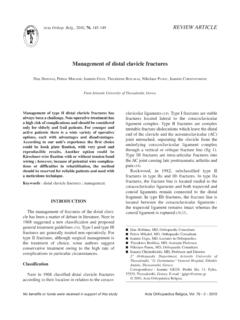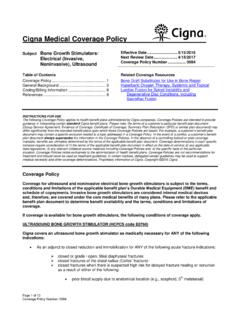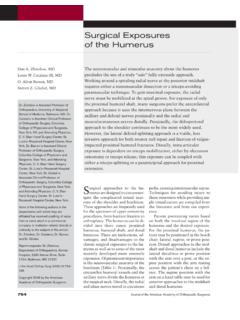Transcription of Forearm and Distal Radius Fractures in Children
1 Forearm and Distal Radius Fractures in Children Kenneth I Noonan, MD, and Charles T Price, MDDr. Noonan is Assistant Professor of Orthopoedic Surgery, Indiana University, Indianapolis. Dr. Price is Surgeon in Chief, Nemours Children 's Clinic, Orlando, Fla. Reprint requests: Dr. Price, Nemours Children 's Clinic, 83 W. Columbia Street, Orlando, FL 32806 Copyright 1998 by the American Academy of Orthopaedic SurgeonsPediatric Forearm and Distal Radius Fractures are common injuries. Resultant deformities are usually a product of indirect trauma involving angular loading combined with rotational displacement. Fractures are classified by location, completeness, angular and rotational deformity, and fragment displacement. Successful outcomes are based on restoration of adequate pronation and supina- tion and, to a lesser degree, acceptable cosmesis. When several important con- cepts are kept in mind, these goals are usually met with conservative treatment by reduction and immobilization.
2 Greenstickfractures are reduced by rotating the Forearm such that the palm is directed toward the fracture apex. Complete Fractures are manipulated and reduced with traction and rotation; extremities are then immobilized in well-molded plaster casts until healing, which usually takes about 6 weeks. Radiographs should be obtained between 1 and 2 weeks after initial reduction to detect early angulation. In Fractures at any level in Children less than 9 years of age, complete displacement, 15 degrees of angulation, and 45 degrees of malrotation are acceptable. In Children 9 years of age and older, 30 degrees of malrotation is acceptable, with 10 degrees of angulation for proximal Fractures and 15 degrees for more Distal Fractures . Complete bayonet apposition is acceptable, especially for Distal Radius Fractures , as long as angulation does not exceed 20 degrees and 2 years of growth remains. Operative intervention is used when the fracture is open and when acceptable alignment cannot be achieved or maintained.
3 Single-bone intramedullary fixation has proved Am Acad Orthop Surg 1998;6-146-156 Forearm Fractures in Children are common and are managed differently than similar injuries in adults. Historically, the results of nonoperative treatment of adult Forearm Fractures have been poor, with reports of nonunion, malalignment, and stiffness due to the lengthy imrnobilization required for union. Currently, most adults with both-bone Forearm Fractures are treated by open reduction and internal fixation. In pediatric patients, treatment is primarily nonoperative because of uniformly rapid healing and the potential for remodeling of residual the outcomes in Children are usually good, treatment of individual patients and education of families can be challenging. Beyond the sometimes difficult mechanics of fracture reduction and maintenance, the clinician is faced with controversies regarding techniques of reduction, position of immobilization, and definition of an acceptable purpose of this article is to critically summarize available information and present treatment recommendations based on a literature review and the previous experience of the senior author ( ).
4 The scope of this discussion will be limited to the more common entities, such as pediatric Forearm and Distal Radius Fractures , and will not include articular Fractures , plastic deformation, and fracture -dislocations, such as Monteggia lesions. Functional AnatomyThe ulna is a relatively straight bone around which the curved Radius rotates during pronation and supination. The axis of rotation passes obliquely from the Distal ulnar head to the proximal radial head. The two bones are stabilized distally and proximally by the triangular fibrocartilage complex and the annular ligament, respectively. Further stabilization is provided by the interosseous membrane, with oblique fibers passing distally from the Radius to the ulna; these fibers are somewhat relaxed in supination and tighter in pronator quadratus (distally) and pronator teres (inserting on the middle portion of the Radius ) actively pronate the Forearm , while the biceps and supinator (proximal insertions) provide supination.
5 The insertions of these four muscles can partially account for fragment position in complete Fractures . In Distal -third Fractures , the proximal fragment will be in neutral to slight supination, and the weight of the hand combined with the pronator quadratus tends to pronate the Distal fragment. In proximal-third Fractures , the Distal fragment is pronated, and the proximal fragment is supinated. Mid-shaft Fractures tend to leave both fragments in a neutral position with the Distal fragment slightly pronated and the proximal fragment slightly anatomic differences distinguish pediatric forearms from those of adults. The pediatric radial and ulnar shafts are proportionately smaller, with narrow medullary canals, and the metaphysis contains more trabecular bone. In addition, the periosteum in Children is much thicker than that in adults; this fea- ture can both hinder and help in the management of pediatric Growth and Implications for RemodelingThe proximal and Distal physes provide longitudinal growth, which contributes to remodeling after fracture healing.
6 The Distal radial and ulnar growth plates are responsible for 75% and 81% of the longitudinal growth of each bone, This is consistent with the oft-made observation that Distal Forearm Fractures have greater potential for remodeling than do more proximal Additional remodeling can also be attributed to elevation of the thick osteogenic periosteum after fracture (Fig. 1). Intramembranous ossification by the periosteum will assist in rapid healing and subsequent remodeling of residual diaphyseal Function and Treatment ObjectivesThe goal of treatment of Forearm and Distal Radius injuries is to facilitate union of the fracture in a position that restores functional range of motion to the elbow and Forearm . The predominant motions affected by malunion are pronation and supination, which are a function of skeletal length and axial and rotational alignment. Normal supination from neutral is 80 to 120 degrees; normal pronation from neutral is 50 to 80 It is important to realize that.
7 Normal" motion may not be what is needed for normal function Biomechanical testing has revealed that common activities of daily living require 100 degrees of Forearm rotation, equally split between pronation and Limited pronation is more easily compensated for by shoulder abduction. Secondary concerns include cosmetic alignment; however, acceptable reduction usually precludes gross malalignment. Ulnar alignment is the most important cosmetic determinant. Fig. I In completely displaced pediatric Forearm Fractures , the periosteum is tom and ele- vated. In cases of reversed fracture obliquity, it becomes difficult to reduce the bone end to end with longitudinal traction, as the periosteum tightens around the buttonholed prox- imal end. However, the elevated periosteum does provide a framework for rapid cortical remodeling as bone and cous form along the elevated margin. Classification Specific classification schemes have not been developed, but Fractures are generally categorized according to location, amount of cortical disruption, displacement, angulation, and malrotation.
8 As mentioned previously, we will not address articular Fractures , physeal Fractures , or fracture -dislocations in this article. Three main types of Forearm Fractures will be discussed: greenstick Fractures , complete Fractures , and Distal radial metaphyseal Fractures . Greenstick Fractures are incomplete Fractures with an intact cortex and periosteum on the concave surface. These are usually the result of excessive rotational force. Complete Fractures of both bones of the Forearm are classified by location as being in the proximal, middle, or Distal third. Proper treatment depends on differentiating greenstick and complete Fractures . Completely displaced Distal metaphyseal Fractures of the Radius will be discussed separately because of the differences in reduction and outcome. Mechanism of Injury It is important to have a basic understanding of the forces leading to Forearm fracture , as reductions are often performed in the direction opposite to that of the initial injury.
9 Pediatric Forearm Fractures typically follow indirect trauma,7,8 such as a fall on an outstretched hand. Direct trauma may additionally account for open Fractures , severely displaced Fractures , and those in the proximal Evans described an indirect mechanism of axial compression force in varying directions and degrees of rotation, the latter accounting for different patterns of fragment angulation. The final degree of fragment displacement due to indirect trauma varies between greenstick and complete Fractures , but the initial mechanism of injury is usually the same. In some cases, the force is not sufficient to completely displace the fracture , and therefore a greenstick fracture results. A greenstick fracture in one Forearm bone may coexist with a complete fracture in the other. Radiographically, greenstick Fractures demonstrate angulation due to rotational ,10 Fractures with apex-volar angulation are the result of an axial force applied with the Forearm in supination; Fractures with the less common apex-dorsal angulation are the result of an axial force applied in Reducing a greenstick fracture usually involves rotation in the direction opposite to the deforming force.
10 When indirect or direct trauma exceeds the resistance of the Forearm , complete Fractures of both bones will follow. In severe falls, the bones may initially angulate according to the rotation of the wrist. However, when completely broken by either indirect or direct forces, the bones shorten, angulate, and rotate within the confines of the surrounding periosteum, interosseous membrane, and muscle attachments. Because the final positioning in complete Fractures depends to some degree on the relationship of fracture location and the insertions of the pronating and supinating muscles, reduction is more complex than for simple greensick Fractures . Distal Radius Fractures usually follow a fall on an outstretched hand. The resultant angulation may also be accompanied by rotational deforn-dty. Apex-volar angulation (the most common deformity) is accompanied by supination and apex-dorsal angulation with In our experience, solely ulnar Fractures are less common, and probably result from direct trauma.







